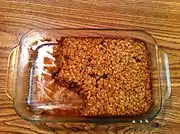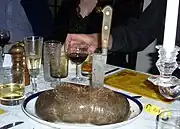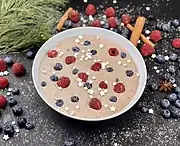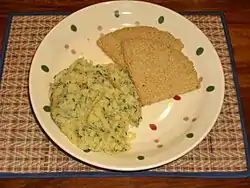 Rolled oats (uncooked) | |
| Alternative names | White oats |
|---|---|
| Region or state | Northern Europe |
| Main ingredients | Oat groats |
Oatmeal is a preparation of oats that have been de-husked, steamed, and flattened, or a coarse flour of hulled oat grains (groats) that have either been milled (ground), rolled, or steel-cut. Ground oats are also called white oats. Steel-cut oats are known as coarse oatmeal, Irish oatmeal, or pinhead oats. Rolled oats were traditionally thick old-fashioned oats, but can be made thinner or smaller, and may be categorized as quick oatmeal or instant oatmeal depending on the cooking time required, which is determined by the size of the oats and the amount of precooking.
Industrial preparation and varieties
The oat grains are de-husked by impact, and are then heated and cooled to stabilize the groats, the seed inside the husk. The groats may be milled to produce fine, medium, or coarse oatmeal.[1]
Rolled oats are steamed and flattened whole oat groats. Old-fashioned oats may be thick and require longer cooking time. Quick-cooking rolled oats are cut into small pieces before being steamed and rolled. Instant oatmeal is cooked and dried, often with a sweetener and flavorings added.[2][3]
Food uses

| Nutritional value per 100 g (3.5 oz) | |
|---|---|
| Energy | 297 kJ (71 kcal) |
12 g | |
| Sugars | 0.3 |
| Dietary fiber | 1.7 g |
1.5 g | |
2.5 g | |
| Vitamins | Quantity %DV† |
| Vitamin A equiv. | 0% 0 μg |
| Thiamine (B1) | 7% 0.08 mg |
| Riboflavin (B2) | 2% 0.02 mg |
| Niacin (B3) | 2% 0.23 mg |
| Pantothenic acid (B5) | 4% 0.197 mg |
| Vitamin B6 | 0% 0.005 mg |
| Folate (B9) | 2% 6 μg |
| Vitamin C | 0% 0 mg |
| Vitamin E | 1% 0.08 mg |
| Vitamin K | 0% 0.3 μg |
| Minerals | Quantity %DV† |
| Calcium | 1% 9 mg |
| Iron | 7% 0.9 mg |
| Magnesium | 8% 27 mg |
| Manganese | 29% 0.6 mg |
| Phosphorus | 11% 77 mg |
| Potassium | 1% 70 mg |
| Sodium | 0% 4 mg |
| Zinc | 11% 1 mg |
| Other constituents | Quantity |
| Water | 83.6 |
| |
| †Percentages are roughly approximated using US recommendations for adults. Source: USDA FoodData Central | |
Both types of rolled oats may be eaten uncooked, as in muesli, or may be cooked with water or milk to make porridge. In some countries, rolled oats are eaten raw or toasted with milk and sugar, sometimes with raisins added, as in muesli. The term 'oatmeal' sometimes refers to a porridge made from the bran or fibrous husk as well as from the kernel or groat.[4] Rolled oats are often used as a key ingredient in granola, in which toasted oats are blended with sugar and/or nuts and raisins, and in granola bars.
Rolled oats are also used as an ingredient in oatmeal cookies, oatcakes, British flapjack bars, and baked oatmeal dessert dishes such as apple Brown Betty and apple crisp. Oats may also be added to foods as an accent, as in the topping on many oat bran breads and as the coating on Caboc cheese. Oatmeal is also used as a thickening agent in savory Arabic or Egyptian meat-and-vegetable soups, and sometimes as a way of adding relatively low-cost fibre and nutritional content to meatloaf.
Nutrition
Unenriched oatmeal, cooked by boiling or microwave, is 84% water, and contains 12% carbohydrates, including 2% dietary fiber, and 2% each of protein and fat (table). In a 100-gram amount, a serving of cooked oatmeal provides 71 Calories and contains 29% of the Daily Value (DV) for manganese and moderate content of phosphorus and zinc (11% DV each), with no other micronutrients in significant quantity (see table on right).
Health effects
Oatmeal and other oat products were the subject of a 1997 ruling by the Food and Drug Administration that consuming oat bran or whole rolled oats can lower the risk of heart disease when combined with a low-fat diet via the effect of oat beta-glucan to reduce levels of blood cholesterol.[5] A similar conclusion was reached in 2010 by the European Food Safety Authority.[6]
A 2023 review found oat consumption can significantly lower blood pressure.[7]
Regional variations
Ireland
In Ireland, stirabout (Irish: leite)[8] was formerly a staple food, made by stirring oatmeal into boiling water or milk to form a thin soup. It could be flavoured with cream, sugar, butter, salt, honey, seeds or fruit on top.[9][10]
Because of its cheapness, and the ease with which it could be prepared in large quantities, stirabout was widely served in institutions like prisons, boarding schools, convents and workhouses.[11] For example, in 1863, children in workhouses received stirabout for their breakfast: made of half oats and half Indian meal, each child got 5 oz (140 g) of meal and 0.5 imp pt (0.28 L) of milk.[12] Similarly, in 1891, district asylum inmates got 6–8 oz (170–230 g) of meal in stirabout every morning.[13] Similarly, in the 20th century, prisoners got between 0.5 imp pt (0.28 L) and 1 imp pt (0.57 L) of stirabout for breakfast in many Irish jails.[14][15][16]
Scotland
Oatmeal has a long history in Scottish culinary tradition because oats are better suited than wheat to the country's low temperatures and high humidity.[17] As a result, oats became the staple grain of Scotland. The ancient universities of Scotland had a holiday called Meal Monday to permit students to return to their farms and collect more oats for food.
Samuel Johnson referred, disparagingly, to this in his dictionary definition for oats: "A grain, which in England is generally given to horses, but in Scotland supports the people." His biographer, James Boswell, noted that Lord Elibank was said by Sir Walter Scott to have retorted, "Yes, and where else will you see such horses and such men?"[18]
In Scotland, oatmeal is created by grinding oats into a coarse powder.[19] It may be ground fine, medium, or coarse, or rolled, or the groats may be chopped in two or three pieces to make what is described as pinhead oatmeal.[20] Ground oatmeal, rolled oats, and pinhead oatmeal, are all used (throughout Britain); one Scots manufacturer describes varieties as "Scottish Porridge Oats" (rolled), "Scottish Oatmeal" (medium ground), and "Pinhead Oatmeal".[21] The main uses are:
- Traditional porridge
- Brose: a thick mixture made with uncooked oatmeal (or medium oatmeal that has been dry toasted by stirring it around in a dry pot over heat until it turns a slightly darker shade and emits a sweet, nutty fragrance) and then adding butter or cream. Quick-cooking rolled oats (distinct from "instant" variations) are often used for this purpose nowadays, because they are quicker to prepare.[20]
- Gruel, made by mixing oatmeal with cold water that is strained and heated for the benefit of infants and people recovering from illness.
- as an ingredient in baking
- in the manufacture of bannocks or oatcakes
- as a stuffing for poultry
- as a coating for Caboc cheese
- as the main ingredient of the Scottish dish skirlie, or its chip-shop counterpart, the deep-fried thickly-battered mealy pudding
- mixed with sheep's blood, salt, and pepper to make Highland black pudding (marag dubh).
- mixed with fat, water, onions and seasoning, and boiled in a sheep's intestine to make marag geal, Outer Hebridean white pudding, served sliced with fried eggs at breakfast. A sweeter version with dried fruit is also known.
- as a major component of haggis.
- in sowans, not strictly made from the meal but as a porridge-like dish made from the fermented inner husks of oats[22][23]
Staffordshire
Staffordshire oatcakes are a local component of the full English breakfast. It is a plate-sized pancake, made with medium oatmeal and wheatmeal (flour), along with yeast. Once the mixture has risen, it is ladled onto a griddle or bakestone and dried through. Staffordshire oatcakes are commonly paired with bacon, sausages, mushrooms, kidney, and baked beans, among others.[24] A related oatcake is sometimes found in neighbouring Derbyshire.
The Netherlands, the Nordic countries, the Baltics and Russia
Throughout the Netherlands, the Nordic countries, the Baltic states and Russia, oatmeal porridge made from rolled oats and water or milk is a traditional breakfast staple. Known under various local names meaning "oat porridge", "oat flake porridge" or "oatmeal porridge", it is normally made either savoury or sweet by adding salt or sugar, and it is often eaten with added nuts, raisins or dried fruits as well as spices, most commonly cinnamon. Local names for the porridge include Dutch havermoutpap, Swedish havregrynsgröt, Danish havregrød, Norwegian havregrøt or havregraut, Icelandic hafragrautur, Finnish kaurapuuro, Estonian kaerahelbepuder, Latvian auzu pārslu (putra), Lithuanian avižinių dribsnių košė, Polish owsianka and Russian "овсянка" (ovsyanka).
Oatmeal porridge has a long tradition in these regions, but during the Middle Ages porridge made from rye or barley was even more common in at least some parts of the area.[25]
United States
In the United States, oatmeal is often served as a porridge[26] with milk or cream and a sweetener, such as brown sugar or honey. The term oatmeal is used in American English to mean porridge. It may include additional ingredients such as peanut butter, cinnamon or various types of fruits.[27]
Nigeria
In Nigeria, a common oatmeal dish known as Zimbuleh is eaten during the winter months. Traditionally it is sweetened with raw honey and cardamom. In the Eket and Kwa Ibo region it is often served alongside warm milk, and it is customary to pour it into the porridge just moments before eating.
Gallery
 Quaker-brand single-serving flavoured "instant" oatmeal packet to make a quick oat porridge
Quaker-brand single-serving flavoured "instant" oatmeal packet to make a quick oat porridge Baked oatmeal in a dish
Baked oatmeal in a dish Oatmeal is a prime ingredient of haggis, seen here at a Burns supper
Oatmeal is a prime ingredient of haggis, seen here at a Burns supper Porridge made from 1-minute quick-cooking rolled oats with raisins, peanut butter, honey, and cinnamon.
Porridge made from 1-minute quick-cooking rolled oats with raisins, peanut butter, honey, and cinnamon. Apple oatmeal pizza
Apple oatmeal pizza Finely ground oatmeal with berries
Finely ground oatmeal with berries Oatcakes (top) with clapshot
Oatcakes (top) with clapshot Atholl brose, a Scottish beverage
Atholl brose, a Scottish beverage White (left) and black (right) puddings containing oatmeal
White (left) and black (right) puddings containing oatmeal![Packaged Dutch havermoutpap from Melkunie [nl]](../I/Havermoutpap_van_Melkunie.jpg.webp) Packaged Dutch havermoutpap from Melkunie
Packaged Dutch havermoutpap from Melkunie
See also
- Brenntar (oat porridge)
- Congee, a rice porridge eaten in Asian countries
- Finnish bread
- Oatmeal raisin cookie
- List of porridges
References
- ↑ "Nairn's (2010)". Nairns-oatcakes.com. Archived from the original on 2011-07-18. Retrieved 2012-10-08.
- ↑ Trowbridge Filippone, F. (2007) "Oatmeal Recipes and Cooking Tips" Archived 2009-05-25 at the Wayback Machine About.com
- ↑ Hosahalli Ramaswamy; Amalendu Chakraverty; Mujumdar, Arun S.; Vijaya Raghavan (2003). Handbook of postharvest technology: cereals, fruits, vegetables, tea, and spices. New York, N.Y: Marcel Dekker. pp. 358–372. ISBN 978-0-8247-0514-5. Retrieved Feb 13, 2010.
- ↑ Prewett's (manufacturer of oatmeal)
- ↑ "21 CFR Part 101; Docket No. 95P–0197; RIN 0910–AA19; Food Labeling: Health Claims; Oats and Coronary Heart Disease" (PDF). US Food and Drug Administration. 23 January 1997. Retrieved 29 July 2017.
- ↑ EFSA Panel on Dietetic Products, Nutrition and Allergies (2010). "Scientific Opinion on the substantiation of a health claim related to oat beta glucan and lowering blood cholesterol and reduced risk of (coronary) heart disease pursuant to Article 14 of Regulation (EC) No 1924/2006". EFSA Journal. 8 (12): 1885. doi:10.2903/j.efsa.2010.1885.
- ↑ Xi H, Zhou W, Niu Y, Zhu R, Wang S, Guo Y, Liu W, Xiong X, Guo L. (2023). "Effect of Oat Consumption on Blood Pressure: A Systematic Review and Meta-Analysis of Randomized Controlled Trials". J Acad Nutr Diet. 123 (5): 809–823. doi:10.1016/j.jand.2022.11.010. PMID 36435335.
{{cite journal}}: CS1 maint: multiple names: authors list (link) - ↑ "Corn and Its Preparations in Ancient Ireland". www.libraryireland.com.
- ↑ "Irish Stirabout".
- ↑ "Irish Stirabout". In an Irish Home.
- ↑ "Soup Kitchens and Workhouses". www.askaboutireland.ie.
- ↑ "Workhouse Diet 1850 - 1900 - Desperate Haven - The Famine in Dungarvan - Waterford County Museum". www.waterfordmuseum.ie.
- ↑ Commons, Great Britain Parliament House of (January 10, 1892). "Parliamentary Papers". H.M. Stationery Office – via Google Books.
- ↑ Oireachtais, Tithe an (July 9, 1931). "Ceisteanna—Questions. Oral Answers. - Cost of Victualling in Prisons. – Dáil Éireann (6th Dáil) – Thursday, 9 Jul 1931 – Tithe an Oireachtais". www.oireachtas.ie.
- ↑ Oireachtas, Houses of the (June 30, 1959). "Written Answers. - Dublin Prison Food Statistics. – Dáil Éireann (16th Dáil) – Tuesday, 30 Jun 1959 – Houses of the Oireachtas". www.oireachtas.ie.
- ↑ University of Southampton (1868). "Circular by Inspectors General of Prisons to Board of Superintendence of Irish County Prisons in reference to proposed Alteration in Prison Dietaries" – via JSTOR.
- ↑ Journal of the Royal Agricultural Society of England. Royal Agricultural Society of England. 1859. p. 169.
- ↑ The Life of Samuel Johnson, LL.D.: Including a Journal of His Tour to the Hebrides. Volume 3 by James Boswell. New York: Derby & Jackson, 1858. Page 11.
- ↑ The Food Journal. London: J.M. Johnson & Sons. 1874. Retrieved Feb 14, 2010.
The grain of oats, intended for human food, is generally prepared by being ground into meal; although it is also used in the form of groats, that is, of grain denuded of its husk, and merely broken into fragments. Oatmeal is of two kinds, both common in all shops in which it is sold, fine meal, and coarse or round meal. For various purposes, some prefer the one and some the other. There is no difference in quality, but merely in the degree in which the grain has been triturated in the mill.
- 1 2 Sybil Kapoor (2010-01-07). "How to make perfect porridge | Life and style". The Guardian. London. Retrieved 2012-10-08.
- ↑ "Oatmeal product list of a Scots manufacturer". Hamlynsoats.co.uk. Retrieved 2018-08-14.
- ↑ McNeill, F. Marian (1929). The Scots Kitchen. Paperback: 259 pages, Edinburgh: Mercat Press; New Edition (25 Oct 2004) ISBN 1-84183-070-4, p202
- ↑ Mairi Robinson, ed. (1987). The Concise Scots Dictionary. Aberdeen University Press. p. 648. ISBN 978-0-08-028492-7.
- ↑ Cloake, Felicity (2018-01-29). "How to make the perfect Staffordshire oatcakes | Food". The Guardian. Retrieved 2018-08-14.
- ↑ Ohlmarks, Åke (1995). Fornnordiskt lexikon. Tiden. p. 115
- ↑ Mariani, John F. (February 4, 2014). Encyclopedia of American Food and Drink. Bloomsbury Publishing USA. ISBN 9781620401613 – via Google Books.
- ↑ "Peanut Butter Oatmeal". www.tasteofhome.com.